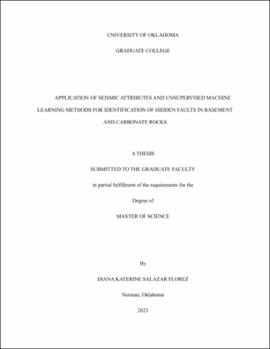| dc.contributor.advisor | Bedle, Heather | |
| dc.contributor.author | Salazar Florez, Diana | |
| dc.date.accessioned | 2023-12-14T17:59:16Z | |
| dc.date.available | 2023-12-14T17:59:16Z | |
| dc.date.issued | 2023-12-15 | |
| dc.identifier.uri | https://hdl.handle.net/11244/340047 | |
| dc.description.abstract | Seismic fault interpretation is a critical task for any type of energy industry and correct fault mapping can be crucial for the success of a project. Common geometric seismic attributes such as coherence and curvature are routinely employed to enhance fault visualization in seismic data, but they can show limitations for sub-seismic faulting. Two projects are presented here showing how recently introduced geometric seismic attributes, such as total aberrancy, and unsupervised machine learning methods, such as self-organizing maps (SOM) and generative topographic mapping (GTM), can be applied for enhancing fault visualization.
The first project focuses on an area with potential for CO2 storage in the carbonates of the Duperow Formation, northern Montana. In this study, we compared broadband and multispectral coherence, curvature, and aberrancy, and we compared SOM and GTM techniques when including and excluding aberrancy attributes. Our results showed that integrating aberrancy attributes during the multiattribute analysis and the machine learning steps considerably enhance the visualization of lineaments with strikes similar to those of fracture sets seen only with well log data and missed by the conventional geometric seismic attributes and the ML scenarios excluding aberrancy attributes.
The second project is related to wastewater injection and induced seismicity in basement-rooted faults in northcentral Oklahoma. Here, different geometric seismic attributes were analyzed and integrated using unsupervised machine learning to identify potential basement-rooted faults and strike-slip-related structures. The machine learning results not only confirmed the existence of NE-SW faults that extend from the basement upward into the sedimentary section and that correlated with earthquake data but also the potential existence of other NE-SW structurally controlled features of anticlinorium shape. | en_US |
| dc.language | en | en_US |
| dc.rights | Attribution 4.0 International | * |
| dc.rights.uri | https://creativecommons.org/licenses/by/4.0/ | * |
| dc.subject | machine learning | en_US |
| dc.subject | seismic attributes | en_US |
| dc.subject | fault interpretation | en_US |
| dc.title | Application of seismic attributes and unsupervised machine learning methods for identification of hidden faults in basement and carbonate rocks | en_US |
| dc.contributor.committeeMember | Carpenter, Brett | |
| dc.contributor.committeeMember | Walter, Jacob | |
| dc.date.manuscript | 2023-12-07 | |
| dc.thesis.degree | Master of Science | en_US |
| ou.group | Mewbourne College of Earth and Energy::School of Geosciences | en_US |
| shareok.orcid | 0000-0001-6413-6706 | en_US |

